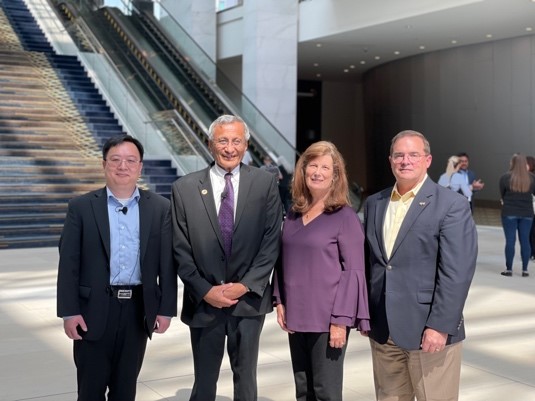Michigan State University Mobility took center stage at the North American International Auto Show Thursday during a panel discussion with its peer institutions from the University Research Corridor, or URC, to highlight how the institution is leading the nation in preparing students who will take their talents into the ever-changing mobility industry.
MSU University Distinguished Professor of Electrical and Computer Engineering and Interim Mobility Director Satish Udpa joined his colleagues from Wayne State University and the University of Michigan for a robust discussion on mobility and higher education in Michigan.
“Mobility-related research and academic offerings are a core focus at Michigan State University and across the URC,” said Udpa. “The work we’re doing has real-life implications for how autonomous vehicles and other new mobility technologies can help residents in Michigan and around the world lead safer, fuller lives.”
MSU has transformed its 5,300-acre campus into a live, connected ecosystem to advance smart-vehicle technology and better understand how it relates to the human element. With a range of urban, suburban, industrial and rural zones, featuring nearly 60 lane miles of roads, MSU’s controlled infrastructure and active campus make it ideal to test emerging technologies for new mobility solutions.

As part of its mobility efforts, the university recently made available one of the nation’s first and largest fully electric autonomous buses. It also made a commitment to invest in a greener future by replacing 369 internal combustion engine vehicles in its fleet with fully electric vehicles over the next decade.
MSU’s excellence doesn’t stop there. Cross-disciplinary faculty are developing and testing the next generation of mobility solutions, ranging from improving battery performance to improving safety by connecting vehicles to the cloud and more.
MSU’s mobility efforts and that of the entire URC reach far beyond bringing mobility solutions to campus.
The URC’s three major research universities — MSU, Wayne State University and the University of Michigan — lead the nation in preparing students who will take their talents into the ever-changing mobility industry, with 14,824 mobility-career graduates — more than top university clusters in California, Texas and Massachusetts. It also prepares more than 46% of Michigan graduates who hold degrees in high demand by the mobility industry, such as business, computer science and engineering degrees.
Over the past five years, the URC has conducted more than $542.4 million in research and development specific to the future of mobility, including work that involves autonomous vehicles, crosswalk and curb sensors, cybersecurity, consumer experiences and the social changes new mobility technology will bring.
The 2022 URC Economic Impact Report showed that for every dollar the state has invested in URC institutions, the URC has put back $22 into the state economy. The three URC universities enroll more than 139,000 students and grant nearly 12,000 degrees in high-tech areas annually.
URC alumni account for nearly $1 out of every $5 in earnings and income statewide — $48.3 billion in fiscal year 2021. URC alumni also founded new businesses at nearly twice the national rate, contributing to the state’s economic growth.
Learn more about MSU’s mobility efforts by visiting mobility.msu.edu.